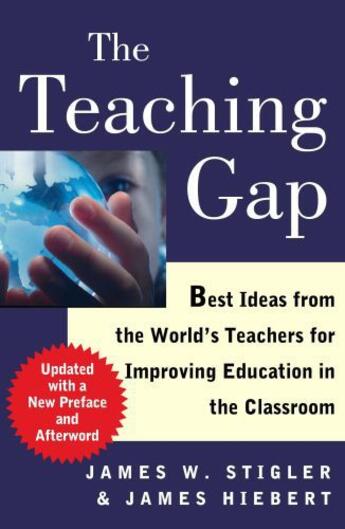-
Nombre de pages : (-)
-
Collection :
(-)
-
Genre :
(-)
-
Thème :
Non attribué
-
Prix littéraire(s) :
(-)
Résumé:
Comparing math teaching practices in Japan and Germany with those in the United States, two leading researchers offer a surprising new view of teaching and a bold action plan for improving education inside the American classroom. For years our schools and children have lagged behind... Voir plus
Comparing math teaching practices in Japan and Germany with those in the United States, two leading researchers offer a surprising new view of teaching and a bold action plan for improving education inside the American classroom. For years our schools and children have lagged behind international standards in reading, arithmetic, and most other areas of academic achievement. It is no secret that American schools are in dire need of improvement, and that education has become our nation's number-one priority. But even though almost every state in the country is working to develop higher standards for what students should be learning, along with the means for assessing their progress, the quick-fix solutions implemented so far haven't had a noticeable impact. The problem, as James Stigler and James Hiebert explain, is that most efforts to improve education fail because they simply don't have any impact on the quality of teaching inside classrooms. Teaching, they argue, is cultural. American teachers aren't incompetent, but the methods they use are severely limited, and American teaching has no system in place for getting better. It is teaching, not teachers, that must be changed. In The Teaching Gap, the authors draw on the conclusions of the Third International Mathematics and Science Study (TIMSS) -- an innovative new study of teaching in several cultures -- to refocus educational reform efforts. Using videotaped lessons from dozens of randomly selected eighth-grade classrooms in the United States, Japan, and Germany, the authors reveal the rich, yet unfulfilled promise of American teaching and document exactly how other countries have consistently stayed ahead of us in the rate their children learn. Our schools can be restructured as places where teachers can engage in career-long learning and classrooms can become laboratories for developing new, teaching-centered ideas. If provided the time they need during the school day for collaborative lesson study and plan building, teachers will change the way our students learn. James Stigler and James Hiebert have given us nothing less than a "best practices" for teachers -- one that offers proof that how teachers teach is far more important than increased spending, state-of-the-art facilities, mandatory homework, or special education -- and a plan for change that educators, teachers, and parents can implement together.
Donner votre avis








